How to Create the Perfect SEO Content Brief in the Era of Ai-Assisted Content
Topic: SEO
Published:
Written by: Bernard Huang
In a world that would have you automate everything, getting into the nitty-gritty details of a content brief seems almost countercultural.
But the content briefing step is still an essential piece of any content production process.
Below, I’m going to walk through successful briefing requirements and principles that I’ve used for years—previously with my own SEO consulting clients, with Clearscope clients, and now with my internal team.
I’ll show you how to do this in Clearscope (it’s easy), but you’ll still benefit from this guide if you’re not a Clearscope user.
Plus, there are no affiliate links in this article, and I’m not trying to sell you any courses or templates here. Scout's honor.
However, I will show you how earning top rankings and organic visibility can be streamlined with the right tools.
And I’ll provide you with one of our team’s brief examples at the end of this article that you can steal and make your own.
Prefer to learn through video? Check out this Clearscope webinar on creating SEO content briefs and outlines. However, the article below includes the most updated information on SEO content briefs for the era of AI-assisted content.
Is the work of creating detailed content briefs worth it?
You bet.
But don’t just use a grab-and-go template you’ve found on the web and pass it out to your digital marketing team—yes, even the one I'm going to provide you at the end of this article.
You need to develop an effective SEO content brief that meets the needs of your team, stakeholders, and target audience.
Now that we've entered the era of AI-assisted and AI-generated content, Google's AI overviews, crucial EEAT requirements, I believe the briefing step is more important than ever before.
It's where you can direct writers, subject matter experts, and stakeholders before they make any wrong turns. And it's also where you can ensure information gain is being considered at every step of the content creation process.
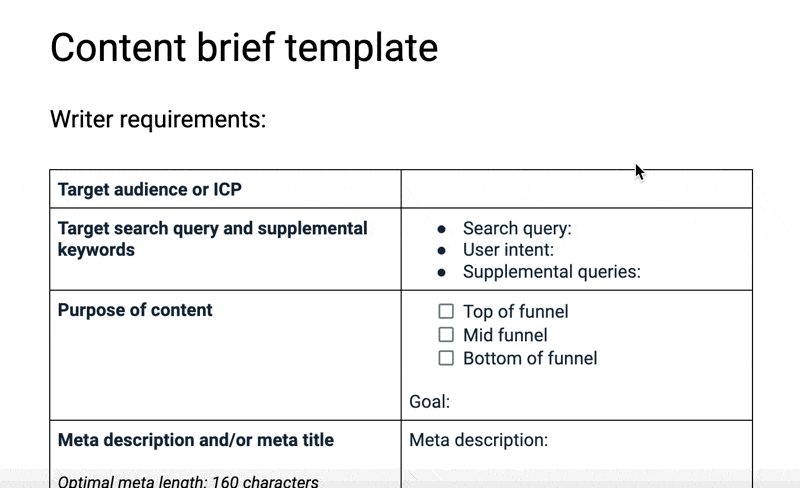
Content brief template that includes notes about information gain and GPT use, as developed by our Clearscope team.
But ultimately...
Building a thorough SEO-focused content brief for each item in production ensures high-quality content that drives organic traffic and meets your content marketing goals—all while streamlining your workflow and internal communication.
Efficient, high-quality content production is a big reason why my cofounder and I developed Clearscope—to simplify content optimization across teams and large content inventories.
And simplifying processes is vital for smaller teams with limited resources, too—and many marketing strategists I’ve spoken with are working with less these days.
In this guide, I’ll walk you step-by-step to creating a comprehensive SEO content brief that aligns your content strategist, team of writers, and stakeholders.
Here is a quick overview of the steps I’m going to cover:
Understand your target audience
Perform keyword research and review current SERPs
Define your content’s purpose, noting key elements
Create a detailed content outline
Get specific about on-page SEO requirements
Determine the content length or word count and format
Provide internal and external links
Outline the Call to Action (CTA)
Use your custom content brief template
1. Understand your target audience
Before creating your brief, you need to have a clear understanding of your target audience.
Effective content often targets specific buyer personas to address their needs and pain points.
Define your audience's demographics, pain points, and search intent.
Consider not only what your audience is looking for, but why—and how your content can provide fresh value or a solution.
This step will ensure your content resonates with your target readers, ultimately improving your rankings in the search engine results pages (SERPs).
But don’t stop there. If you have a broad group of searchers that you’re targeting, make sure you’re also noting at the time of content brief creation who exactly in that group this piece is for.
Here are a few examples:
Let’s say you’re a SaaS company for project management software with a target audience of small businesses, large enterprises, project managers, and team leaders. You would need to specify in your content brief if a piece of content is for a startup small business owner, an enterprise project manager, or a team leader of an in-house traditional corporation.
You’re a trusted health and wellness publication for health-conscious individuals, fitness fans, and people with chronic illnesses. To minimize rewrites and offer clarity to your writers, upon your brief creation, you should specify if the content piece is for parents who are trying to get a workout in at home, a health-conscious person seeking to minimize inflammation, or a reader experiencing burnout looking for mental wellness tips.
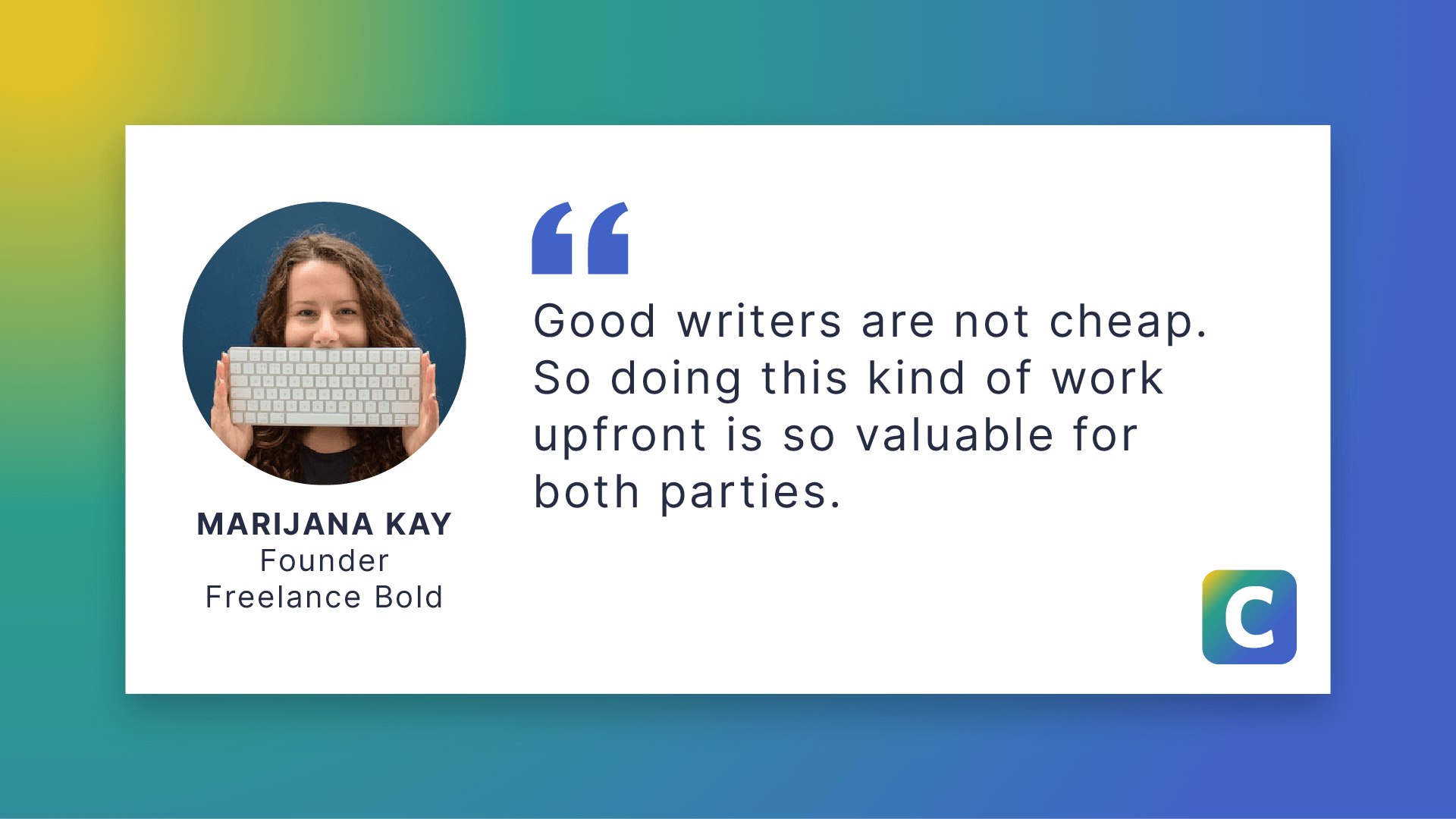
Quote from Marijana Kay: “Good writers are not cheap. So doing this kind of work upfront is so valuable for both parties.”
2. Perform keyword research
This next step is crucial for identifying the target keyword and related keywords (like secondary keywords or long-tail keywords in your niche) that will drive your content strategy.
Many strategists simply use a traditional keyword research tool to find search terms with high search volume and low competition.
Then they pop those specific keywords into their content brief, directing content writers to pepper them in.
If that’s your current process, it needs improvement.

Quote from Omid Ghiam: “Search intent is really important — it’s the root of our ideation process.”
SEO isn’t about keywords anymore.
It’s about targeting search intents, and doing it well. When you do, you’re providing your target reader we discussed in the step above with exactly what they’re looking for.
Focusing on search intent research will help you understand what your audience is searching for—and how to properly optimize your content for search engines and LLMs this year and beyond—ensuring your content appears for relevant search queries.
LEARN MORE: Why search intent optimization beats keyword optimization
3. Define your content’s purpose and goals

Customer journey stages.
Clearly outline the purpose and goals of the content in your brief.
What do you want to achieve with this piece of content?
Whether it's increasing organic traffic, educating your audience, supporting the sales team with education post-lead qualify, or driving conversions, having a clear goal will guide your content creation and ensure your team is on the same page.
The way your content writing addresses a reader who is at the top of the funnel vs. someone at the bottom of the funnel matters.
A good user experience isn’t just about fast page load speed and visible CTA buttons.
It’s also about ensuring your audience is getting the right piece of content with the right amount of sales language at the right time.
4. Create a detailed content outline
A good content brief includes a detailed content outline—not just a high-level table of contents.
Break down the main topic into subtopics, and include headings and subheadings to structure the content.
Here, you’ll also likely want to consider what the SERPs are providing in the results for an organic search of your target query.
Are there featured snippets that show up?
Is there an AI Overview for this particular query?
What People also ask or FAQs are showing up on the results page?
This helps content creators understand the flow of the piece, what SERP features show up on the page so they can target them, and ensures all key points are covered.
Clearscope does this automatically for you all within your content draft.
If you want to get meta for a moment, take a look at what I’m seeing as I work on this article:

Within the Clearscope Reports draft feature, you'll get sharp recommendations for creating an outline, along with insight into your content competitor's article structures.
With Clearscope, you can also create an SEO-informed content outline that’s developed on your target search intent in just a few clicks.

Find your AI Outline generator under Clearscope Reports. Click "Insert" in the top of the editor. Select "Create Outline."
Other tools like Frase and SurferSEO might also offer this function, but those tools tend to have a “push button” SEO philosophy that leans heavily on an AI-generated content approach.
We developed Clearscope because we know that subject matter experts, information gain, and perspectives (aka Ranch-style SEO) is crucial to ranking well. And these practices work.
READ MORE: Should you use AI-generated content in your SEO strategy? It’s not if you use it, but how and why. Get clarity on the pros and cons.
No matter what tool you use, an outline structure aids in creating in-depth, people-first content that thoroughly covers the subject matter, even if you incorporate AI assistance into your content creation process.
5. Specify On-Page SEO Elements
Include on-page SEO elements such as the meta description, URL slug, and headers in your content brief—or request them from the writer if you’re not drafting and providing them yourself.
These elements seem simple, but they are still important for optimization and help search engines understand the context of your content.
Tip: Your primary keyword should be included in meta data if possible and natural, but keyword stuffing is old news.
6. Determine the content length and format
In this step, you need to define the ideal word count and content format in your brief.
The word count should be based on your keyword research and competitive analysis. (Clearscope does this automatically for you within the platform.)
Consider what type of content best suits the topic—whether it's a blog post, listicle, case study, whitepaper, or social media post.
Ensuring your content is sufficiently comprehensive can help it perform better in the SERPs.
Here’s a quick example of how search intent should be informing your content format. (And if you’re following this guide in order, you would complete this in step 1 and 2).
If you're planning on writing a blog article about "how to use Hubspot for email marketing," and you take a quick look at the current SERP results, you’d see the following:

The search results for this query indicate the user intent and ideal content format is Hubspot-created guides or YouTube how-to videos developed by creators.
You can determine pretty quickly from this quick Google search that you either need to be Hubspot to rank for this query, or you need to be incredibly good at YouTube SEO and create a video to get visibility here.
Because those are the results that real people want to see.
Content format meeting search intent matters!
7. Provide internal and external links
Internal links help build topic clusters and keep readers engaged on your site.
Specify which internal links should be included in the content and the preferred anchor text.
(This step is crucial for content optimization and improving the navigational flow of your site.)
Also, you should guide your writers in the brief on adding high-quality external links to credible sources.
And guess what? It’s okay to link to competitor content.
You should be doing what provides the most value to your reader.
If your competitor has a great study your target audience needs to see, why wouldn’t you include it?
Pro-tip for Clearscope users: The Research tab in your Clearscope Report draft highlights key resources your readers may expect. It helps you quickly identify relevant sources, organizations, or studies that will resonate with your audience.
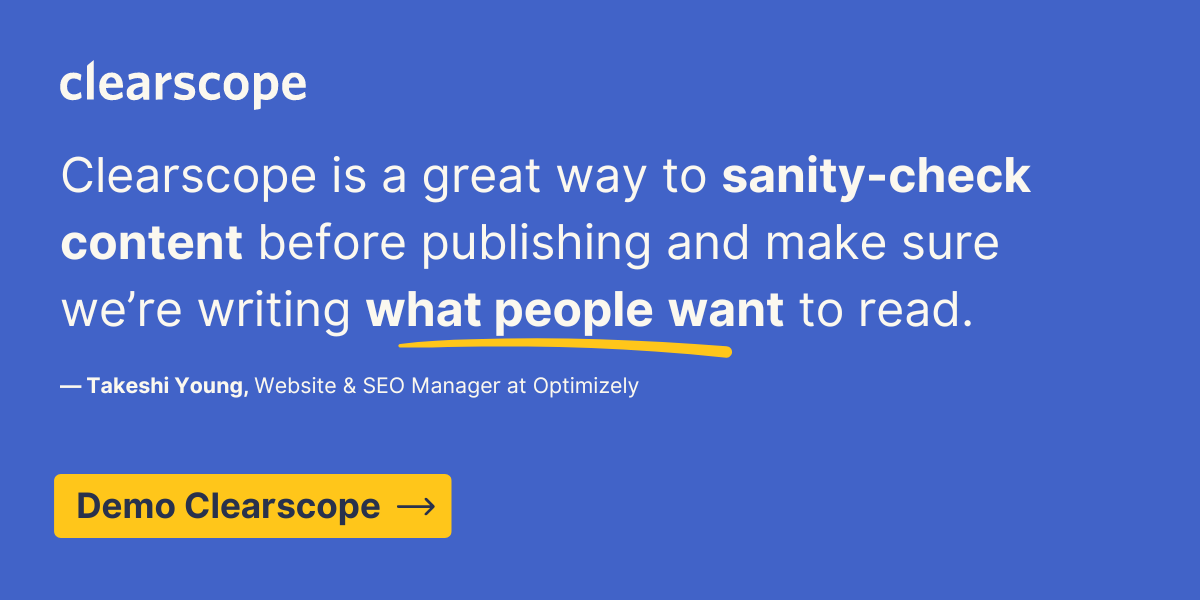
8. Include information gain, style, and brand guidelines
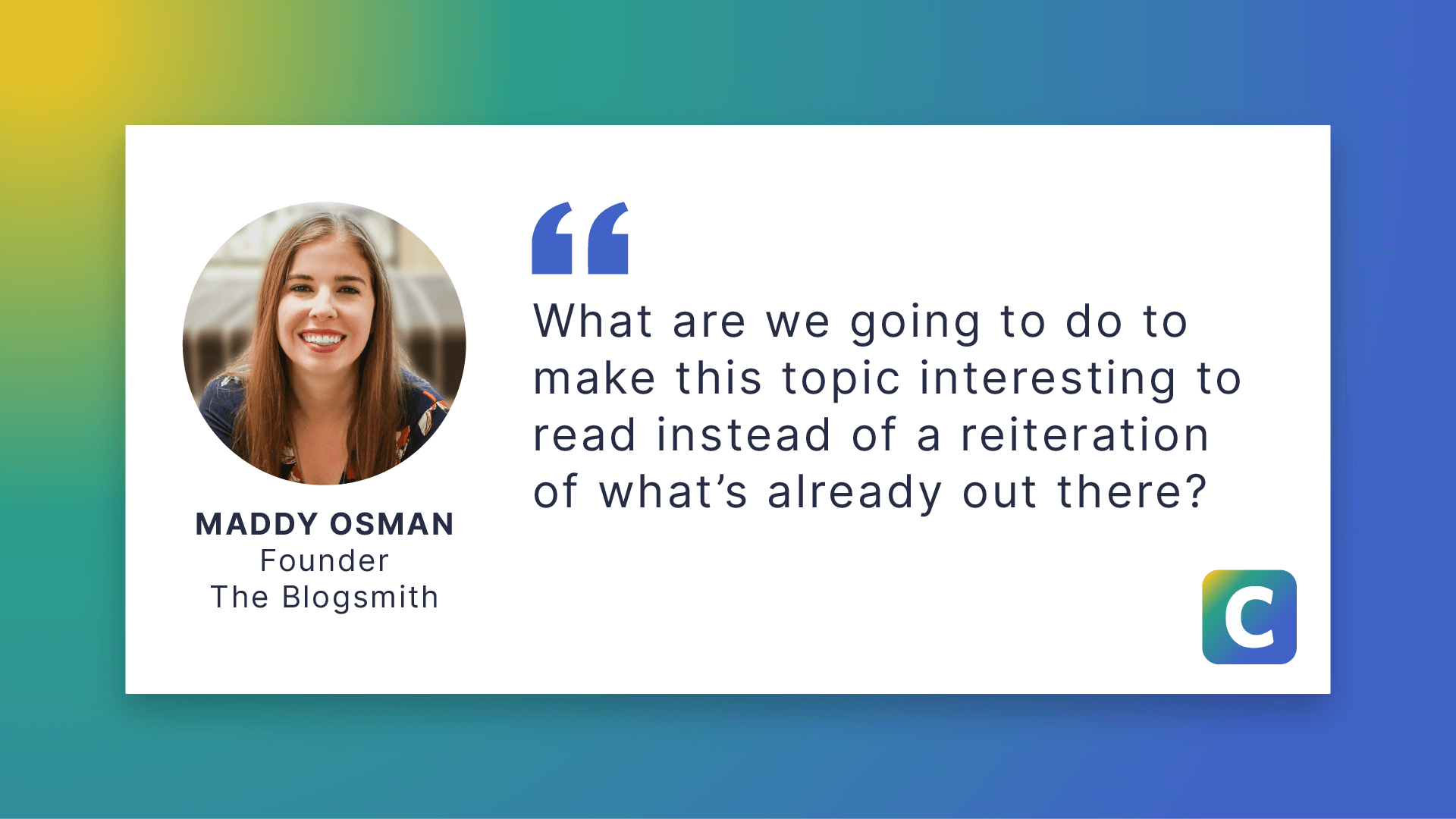
Quote from Maddy Osman: “What are we going to do to make this topic interesting to read instead of a reiteration of what’s already out there?”
This is pretty standard, but you’re going to want to ensure your content aligns with your brand voice by including your style guide in the brief.
This helps freelance writers or an in-house team understand your brand's tone and style, ensuring consistency across all content.
Consistent branding is key to creating great content that resonates with your audience.
But don’t stop there.
You should be including information gain across the content you’re producing, and if you’ve created an information gain swipe file, you’ll also want to give your writers access to this document in the content brief.

Quote from Garrett Sussman of iPullRank.
9. Outline the Call to Action (CTA)
Every good marketer knows that all content should have a clear call to action.
Define the CTA in your brief based on the content's purpose and the target audience's stage in the customer journey.
Whether it's subscribing to a newsletter, downloading a guide, or making a purchase, the CTA should be clear and compelling, guiding searchers toward a desired action.
10. Plan for revisions and feedback
A good content brief should include a plan for revisions. Edits can be time-consuming, and honing-in on a process that works for your team is important.
Outline how the feedback process will work and set expectations for the number of revisions.
This ensures the final deliverable meets your standards and aligns with your initial intent.
Typically, the writing process involves creating a first draft, gathering feedback, and making necessary adjustments.
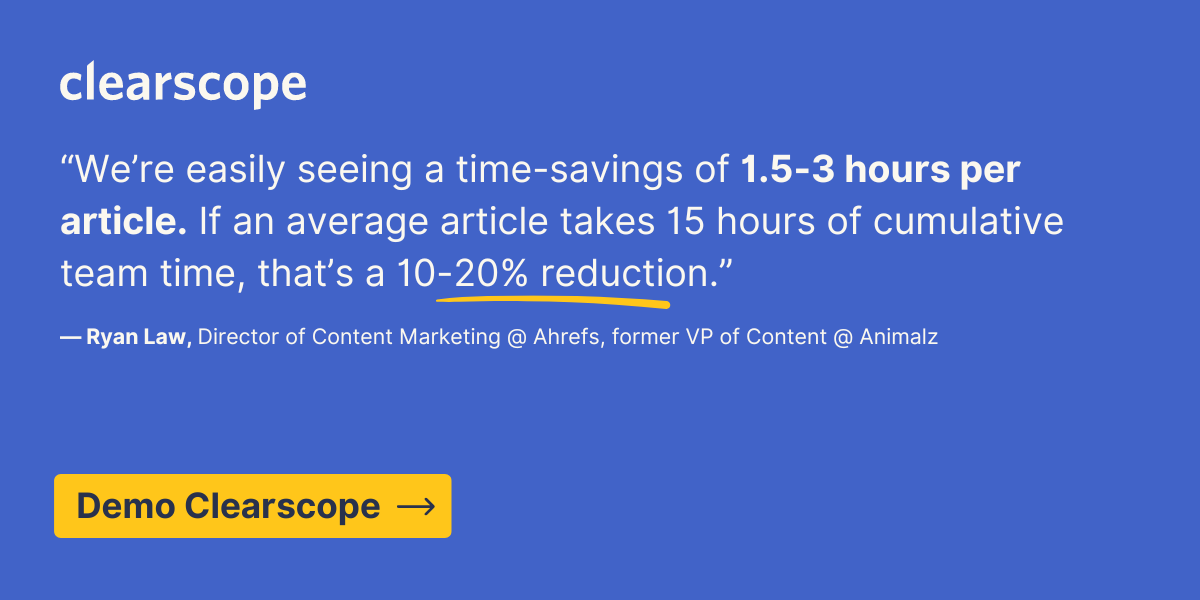
11. Use your custom content brief template
Streamline your workflow by creating a content brief template based on the steps outlined above.
And then use it. All the time.
This ensures consistency across your content strategy and helps your team quickly create briefs going forward.
The template should work for your content team and stakeholders—not someone else’s. Take the time to make it work for you.
Here’s a content brief template example that we developed in house to get you started, but remember, make it your own. (No email address is required to access.)
And then, if you’re a Clearscope user, you can easily store your custom brief templates and use them again and again—all directly in the platform.
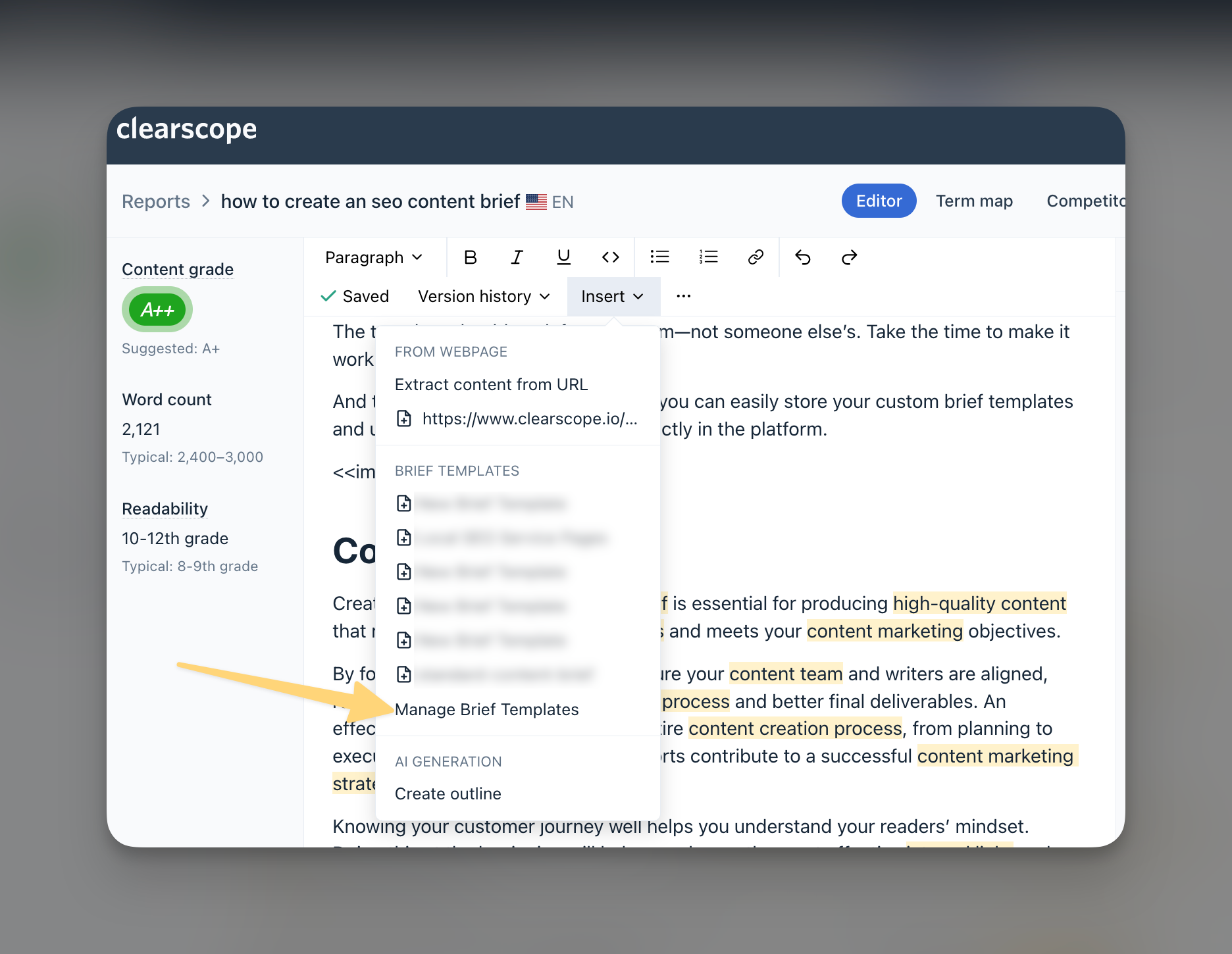
Clearscope allows you to manage all your custom brief templates within the platform.
Contributing authors and updates
The original version of this article was published in 2023. It was revised October 9, 2024, to include updated education on current best practices by the Clearscope team.
How to Write SEO Content that Ranks on Google
Learn how to write SEO content that ranks on Google.
Read moreTopic Clusters: What Are They? Do They Help Your SEO? (with Video)
Learn how to implement a topic cluster strategy with our step-by-step guide plus a video.
Read moreOn-Page SEO: What it is, Why it Matters, & How To Optimize
Here’s what industry experts have to say about on-page SEO. Learn what it is, why it’s important, and how to use it to improve your organic traffic.
Read more